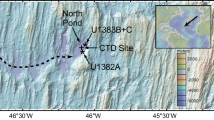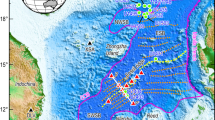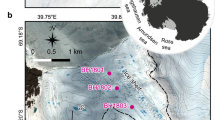Abstract
ALTHOUGH there is indirect evidence that a major fraction of the heat loss from newly-created lithosphere occurs by convection of seawater through the porous crust1–3, it has proved difficult to locate vents of deep-sea hydrothermal systems by direct measurement of the discharge fluid. Local increases in bottom water temperature up to 0.1 °C have been measured by towing arrays of thermistors a few metres above the axes of active oceanic spreading centres4,5, but these data are ambiguous because small temperature anomalies may have a hydrographic explanation. We report here the first conclusive measurements of modified seawater discharging as buoyant hydrothermal plumes from fissures in young oceanic crust. We obtained samples of hydrothermal plumes in the Galapagos Rift3, albeit after considerable dilution with surrounding bottom-water, and report the first results of the collection and analysis of these samples.
This is a preview of subscription content, access via your institution
Access options
Subscribe to this journal
Receive 51 print issues and online access
$199.00 per year
only $3.90 per issue
Buy this article
- Purchase on Springer Link
- Instant access to full article PDF
Prices may be subject to local taxes which are calculated during checkout
Similar content being viewed by others
References
Talwani, M., Windisch, C. C. & Langseth, M. G. J. Geophys. Res. 76, 473–517 (1971).
Lister, C. R. B. Geophys. J.R. astr. Soc. 26, 515–535 (1972).
Sclater, J. G. & Klitgord, K. D. J. Geophys. Res. 78, 6951–6975 (1973).
Williams, D. L., Von Herzen, R. P., Sclater, J. G. & Anderson, R. N. Geophys, J.R. astr. Soc. 38, 587–608 (1974).
Rona, P. A., McGregor, B. A., Betzer, P. R. & Krause, D. C. Deep-Sea Res. 22, 611–618 (1975).
Craig, H. Hot Brines and Recent Heavy Metal Deposits in the Red Sea (eds Degens, E. T. & Ross, D. A.) Springer-Verlag, New York, 208–242 (1969).
Lupton, J. E., Weiss, R. F. & Craig, H. Nature 266, 244–246 (1977).
Bischoff, J. L. & Dickson, F. W. Earth Planet. Sci. Lett. 25, 385–397 (1975).
Spiess, F. N. & Mudie, J. D. The Sea (ed. Maxwell, A. E.) 205–220 (John Wiley and Sons, New York, 1970).
Laird, N. P. J. Mar. Res. 29, 226–234 (1971).
Detrick, R. S., Williams, D. L., Mudie, J. D. & Sclater, J. G. Geophys. J.R. astr. Soc. 38, 627–637 (1974).
Lupton, J. E., Weiss, R. F. & Craig, H. Nature 267, 603–605 (1977).
Klitgord, K. D. & Mudie, J. D. Geophys. J.R. astr. Soc. 38, 563–586 (1974).
Lonsdale, P. Geology 5, 147–152 (1977).
Author information
Authors and Affiliations
Rights and permissions
About this article
Cite this article
WEISS, R., LONSDALE, P., LUPTON, J. et al. Hydrothermal plumes in the Galapagos Rift. Nature 267, 600–603 (1977). https://doi.org/10.1038/267600a0
Received:
Accepted:
Issue Date:
DOI: https://doi.org/10.1038/267600a0
This article is cited by
-
Hydrothermal vent fauna of the Galápagos Rift: updated species list with new records
Marine Biodiversity (2024)
Comments
By submitting a comment you agree to abide by our Terms and Community Guidelines. If you find something abusive or that does not comply with our terms or guidelines please flag it as inappropriate.



